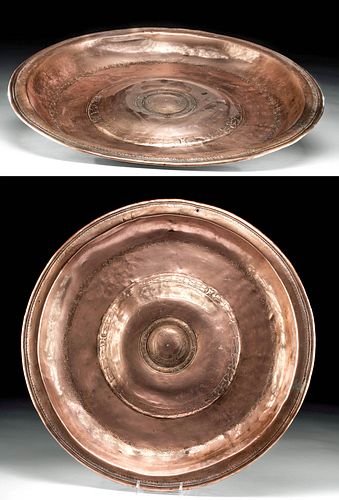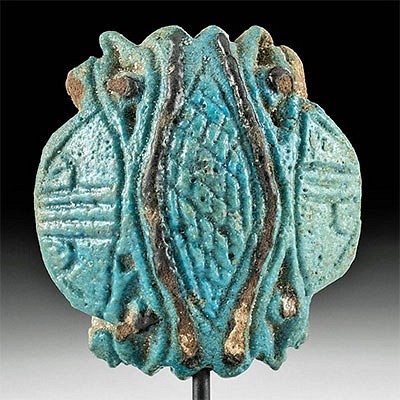16th C. German Copper Alms Plate w/ Double Headed Eagle
Lot 58
About Seller
Artemis Gallery
686 S Taylor Ave, Ste 106
Louisville, CO 80027
United States
Selling antiquities, ancient and ethnographic art online since 1993, Artemis Gallery specializes in Classical Antiquities (Egyptian, Greek, Roman, Near Eastern), Asian, Pre-Columbian, African / Tribal / Oceanographic art. Our extensive inventory includes pottery, stone, metal, wood, glass and textil...Read more
Categories
Estimate:
$1,500 - $2,000
Absentee vs Live bid
Two ways to bid:
- Leave a max absentee bid and the platform will bid on your behalf up to your maximum bid during the live auction.
- Bid live during the auction and your bids will be submitted real-time to the auctioneer.
Bid Increments
| Price | Bid Increment |
|---|---|
| $0 | $25 |
| $300 | $50 |
| $1,000 | $100 |
| $2,000 | $250 |
| $5,000 | $500 |
| $10,000 | $1,000 |
| $20,000 | $2,500 |
| $50,000 | $5,000 |
| $100,000 | $10,000 |
| $200,000 | $20,000 |
About Auction
By Artemis Gallery
May 27, 2021
Set Reminder
2021-05-27 10:00:00
2021-05-27 10:00:00
America/New_York
Bidsquare
Bidsquare : CLEARANCE | Antiquities & Ethnographic Art
https://www.bidsquare.com/auctions/artemis-gallery/clearance-antiquities-ethnographic-art-7010
Featuring discounted pricing and many new items! Asian art, Classical antiquities from Egypt, Greece, Italy, and the Near East...plus Pre-Columbian, Tribal, Russian Icons & Enamelware, Spanish Colonial, Fine Art, more! Some starting prices have been reduced up to 65% from original auction prices! Artemis Gallery info@artemisgallery.com
Featuring discounted pricing and many new items! Asian art, Classical antiquities from Egypt, Greece, Italy, and the Near East...plus Pre-Columbian, Tribal, Russian Icons & Enamelware, Spanish Colonial, Fine Art, more! Some starting prices have been reduced up to 65% from original auction prices! Artemis Gallery info@artemisgallery.com
- Lot Description
**Originally Listed At $800**
Central Europe, Holy Roman Empire - Late Renaissance/Early Baroque (region of modern day Germany/Austria), ca. 16th to 17th century CE. A large, rare copper alms plate featuring at its center a double-headed eagle motif, the coat of arms of the Holy Roman Empire. Scrolling and floral motifs encircle it while further abstract decoration is on the narrow, flat rim. It is rare to find one with such a high percentage of copper in its alloy - most are brass or bronze whereas this one gleams with the pink color of near-pure copper. Size: 17.8" W x 1.1" H (45.2 cm x 2.8 cm)
In the early 16th century, alms dishes had become very wide in diameter, with a wide base and ample room for designs. Many were produced in Nuremberg, with others made in Flanders, Bouvignes, and Aachen, but craftsmen in each city shared techniques, making the plates difficult to assign to a single area of manufacture. When Charles the Bold took the city of Divant in Flanders in 1466, metalworkers fled from there to neighboring areas, further spreading this technology and artistic style. These dishes were not just used for alms - or even, depending on location, primarily. Exported to the British Isles, they found their way to churches there as alms plates, but on continental Europe, paintings often show them used as basins for washing hands after a meal. Prior to forks being commonly used in the 17th century, this was a necessary part of the table. See a very similar example in the Victoria & Albert Museum.
Provenance: private San Francisco, California, USA collection, acquired 1970s to 2000s
All items legal to buy/sell under U.S. Statute covering cultural patrimony Code 2600, CHAPTER 14, and are guaranteed to be as described or your money back.
A Certificate of Authenticity will accompany all winning bids.
We ship worldwide and handle all shipping in-house for your convenience.
#137912Slight bending to form. Patina has been kept cleaned everywhere except in the lower profile areas. Nice preservation of motifs. Small, deliberate puncture through rim in order to hang it on a wall.Condition
- Shipping Info
-
All shipping is handled in-house for your convenience. Your invoice from Artemis Gallery will include shipping calculation instructions. If in doubt, please inquire BEFORE bidding for estimated shipping costs for individual items.
-
- Buyer's Premium



 EUR
EUR CAD
CAD AUD
AUD GBP
GBP MXN
MXN HKD
HKD CNY
CNY MYR
MYR SEK
SEK SGD
SGD CHF
CHF THB
THB
















